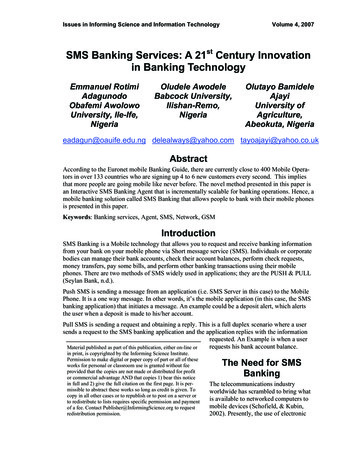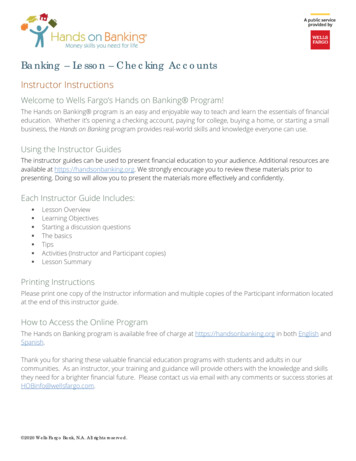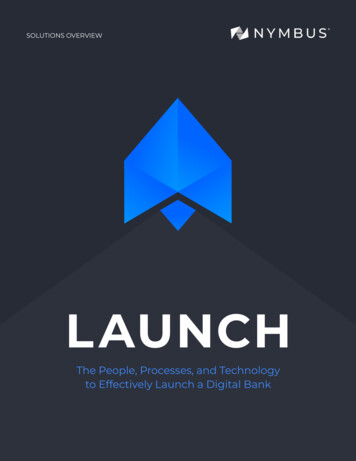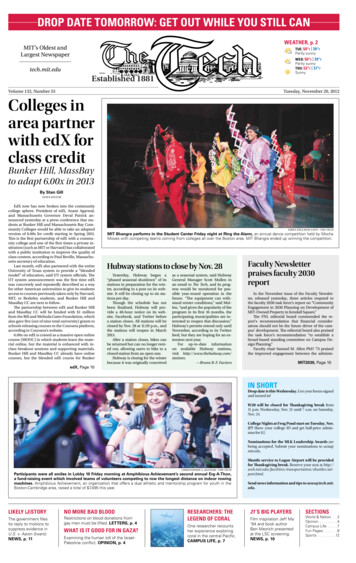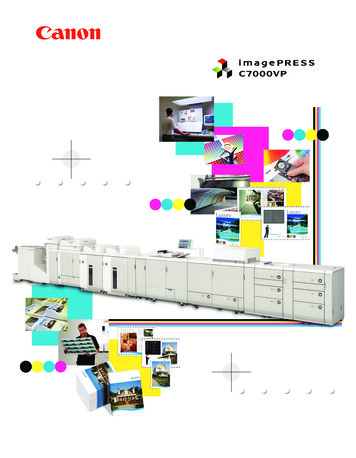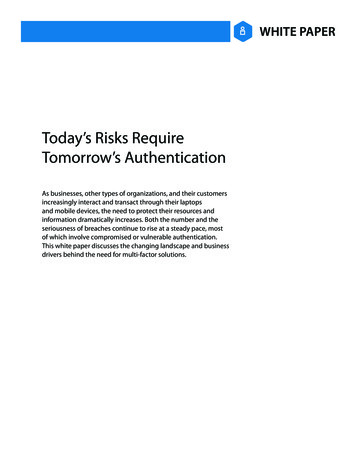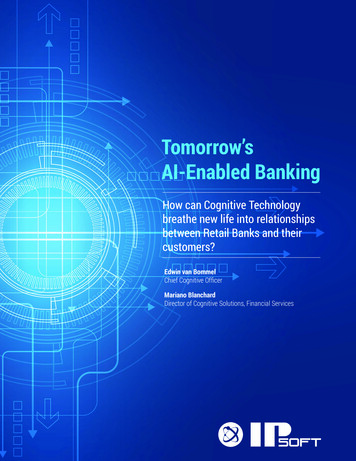
Transcription
Tomorrow’sAI-Enabled BankingHow can Cognitive Technologybreathe new life into relationshipsbetween Retail Banks and theircustomers?Edwin van BommelChief Cognitive OfficerMariano BlanchardDirector of Cognitive Solutions, Financial Services1
Executive SummaryRetail banking is facing the deepestlevel of disruption in decades.Shifting customer needs and a generation of millennials resistant to traditional bankingmethods are challenging established models. After years of incremental change banks need toplan for a fundamental rethink of operations in order to thrive in a rapidly digitized and data-driven world. Customers expect access to information and resources at all times.Although consumer relationships in the retail bankingspace have never been particularly strong, a recentmillennial survey revealed that all four of today’s leading banks are amongst the ten least loved brands bymillennial consumers.1 To a certain extent, this may beconnected to the financial crisis that began in 2007.Today’s generation is dealing with a dearth of jobs andincreasing student loans and personal debt, which hasincreased skepticism and has diminished trust between younger customers and retail banks. As a result,today’s hyper-connected consumer associates personal finance with crowdfunding, virtual currencies andonline payment apps — rather than paper checks, bankbranches and ATMs.Due to an increasing number of FinTech entrants andemerging startups, competition across all industries isfierce. Against this backdrop, customer loyalty and retention is paramount to success, making it critical forretail banks to reform their business models quickly.The cost of winning customer loyalty is equally critical. McKinsey & Company indicates that the primary driver of industry return on equity (ROE) growthhas been operational effectiveness ( 1.69%, 20132014 change)2, implying that those banks unable toadapt their cost structure in the face of decreasingmargins are at risk of not creating economic value.The largest banks have announced aggressive costcutting measures that promise to shave 20% of operations but they do so in such a hotly contestedmarket that any sacrifice in quality of customer experience that their program causes will be heavilypenalized by customers who have a fast growingwealth of alternatives. A further pressure on operational costs is the ability to absorb the demands ofmounting compliance regulations. Together thesecompetitive pressures represent a significant threatto the status quo. Studies have already revealedthat within the five major retail banking businesses(consumer finance, mortgages, SME lending, retail1 Viacom Media Networks, March 2014, "The Millennial Disruption Index"2 McKinsey & Company, September 2015, “The Fight for the Customer:McKinsey Global Banking Annual Review 2015"2
Banks that harness cognitive technology will gain the advantageof faster digitization and provide customers with cross-channel,targeted, on-time products and services.payments and wealth management), up to 40% of revenues, in addition to 20-60% of profits, will be at riskby 2025 – with consumer finance the most vulnerableline of business.3After years of promise, artificial intelligence (AI) andcognitive computing have reached maturity and arenow ready to implement. The McKinsey Global Institute estimates that the economic impact of the automation of knowledge work will reach USD 6.7 trillionannually by 2025.4 AI will provide a catalyst for operational change that has the potential to unleash unprecedented growth for legacy industries, like banking.AI will make it possible to automate vast proportionsof knowledge work, managing data at record speedsand capacities while harnessing the same informationfor invaluable insights. New cognitive-based solutionswill also enable a more pro-active and personal customer experience at low cost. This is driven by AI'sability to build knowledge at high speed, understandnatural language, and run operational processes in afully compliant fashion.3 McKinsey & Company, September 2015, “The Fight for the Customer:McKinsey Global Banking Annual Review 2015"4 McKinsey & Company MGI, May 2013, “Disruptive Technologies: Advancesthat will transform life, business, and the global economy”Impact of the automationof knowledge work 6.7 trillionby 2025With new capabilities that can optimize value rapidly, banks can both compete and team with FinTechentrants and other disruptors such as robo-advisorsthat have quickly gained mass appeal amongst customers of all demographics, regional markets andsocioeconomic groups.Banks that harness cognitive technology will gainthe advantage of faster digitization and provide customers with cross-channel, targeted, on-time products and services. This report will examine currentand future applications for cognitive technology inthe retail banking sector and provide tangible insights into how executives can plan for this transformation.3
Winning Customer Loyaltyin the Age of Agile StartupsAI will only be impactful if customers are willing to engage with it and that means understanding how thistechnology can best be leveraged to meet changingcustomer preferences.The advent of the internet has created the most educated generation of financial services customers in history.These "millennial" customers have access to constantcomparison information and visibility of alternative financial solutions which have seized considerable market share from more traditional financial institutions.Winning the trust and loyalty of millennials, however, isbecoming more and more difficult, as increased competition has made it harder for retail banks to differentiatebased on pricing or offerings alone. Indeed, customersaround the world have reported an increased likelihoodto change service providers, with 52.7% of millennialcustomers likely to switch their banks by 2016.5The most disruptive competitors for retail banks are notdirect industry players, but a growing set of competitorsthat lie outside traditional banking models. A constantstream of FinTech start ups and solutions are shakingup the market, while simultaneously driving larger riftsbetween retail banks and their consumers. Analyzingsuccessful FinTech initiatives shows that the principal factors customers want are: (1) cross-platform, (2)straight-through response 24x7, (3) easy to use and (4)low cost. FinTech companies offer the same cross-platform experience for financial services as consumersexpect from their favorite apps and online services. Accessible anywhere at any time is the starting point. Customers can open a bank account in minutes with BankSimple or get immediate confirmation of a loan throughLending Club. Both these services offer the same simplestraight-through process that consumers have cometo expect through other services such Facebook Messenger. The price point of FinTech offerings is typicallylower than that of traditional banks too. While each individual start-up might not appear to pose a major threatto banks, when they are acquired by large global playersand assimilated into a broader services their influencecan change overnight. Take for example Future Advisor,a robo-adviser that suddenly achieved global reach andresources when it became part of BlackRock.5 Capgemini, April 2015, “World Retail Banking Report 2015”4
Another source of competitive threat is coming fromlarge global enterprises, such as online retailers, thatfully integrate important banking processes within theirown broader business experience. They minimize thebanking activity to an administrative necessity and because these companies fall outside of bank regulations,they are able to operate at much lower costs than traditional banks, and so offer lower prices for customers.field as new players prove so adept at circumnavigating them. The second source of advantage one mightconsider is capital. Banks have the capital necessary forlending at scale but again FinTech players are catchingup with the banks. They can benefit from investments bypension and hedge funds, for example, that are lookingfor capital gains yielding more than the low interest ratescurrently available.Large global B2B and B2C platforms like Alibaba andAmazon offer lending products as part of a buying experience. These organizations are able to underwritethese loans themselves and are looking for bankingbalances to finance these loans. Even retail giants,such as Walmart, are now offering checking accountproducts.The third area of advantage for the established banks istrust, traditionally a prime characteristic for banks. Unfortunately, this advantage is slipping away as consumer confidence grows stronger for non-bank financial services providers. A recent global study found that 83.4% ofbank executives believe their customers are comfortablewith conducting their banking through internet and technology companies, but only 64.8% of executives believetheir customers are comfortable banking at traditionalbanks.6 In 2014, an astounding 73% of millennials statedthey would rather handle their financial services needswith Google, Amazon, Apple, PayPal or Square than withtheir own nationwide bank.7Established technology giants (such as Apple, Amazon and Facebook), as well as FinTech startups, offernew services that will likely increase the size of thepayments market especially as cash usage declinesand cross-selling opportunities arise from better use ofdata.Where do banks still have an advantage? Regulations,as already noted above, may not even out the playing52.7%of millennials are likely toswitch their banks by 20166 Capgemini, April 2015, “World Retail Banking Report 2015”7 Viacom Media Networks, March 2014, "The Millennial Disruption Index"64.8%of executives believe theircustomers are comfortablebanking at traditional banks.73%of millennials would rather useGoogle, Amazon, Apple, PayPal orSquare than a nationwide bank5
Tomorrow’s AI enabled bankingArtificial Intelligence technologies will not have an isolated impact on banking operations.Technology is changing the fundamental processes carried out in every part of the structure and how they linktogether (see diagram opposite). In tandem, the roles ofbank staff will evolve from executing operations directlyto managing the AI systems that execute work.In order to take a closer look at the impact on processes, we can segment a bank’s operations into its five corefunctions. These are (1) front-office including branches,call centers, mobile channels; (2) back-office functionssuch as data entry and processing; (3) the financialbackbone functions such as Asset Liability Management [ALM]; (4) the analytics functions that focus on riskand opportunity management; (5) and the policy settingfunctions such as those managing regulations, specificproducts and so on.The analytics function is often talked about as a newbanking function. In truth, however, it is one of the oldestfunctions. Credit risk management, fraud detection, market projections are all traditional, analytics driven bankingroles. In practice, however, this area is moving fast frombeing seen as an art to a science. AI makes it possibleto use advanced analysis techniques, such as machinelearning and apply it to huge amounts of data in a waythat was not previously possible. For instance, solutionslike Watson or Sentient Technologies can analyze hugeamounts of structured and unstructured data to deliverrecommendations to advisors or traders. These solutions will enable banks to make important decisions inreal-time. For example, they will support instant creditdecisions or cross-sell suggestions. Smaller start-upslike Narrative Science enable banks to turn complex analytics into simple stories people can understand and acton. In addition, machine learning tools like R are boostingthe effectiveness of marketing related analytics by enabling strategies on ‘next product to buy’, churn prevention and micro-pricing.In the front-office, cognitive agents will automate an increasing amount of customer contact. Powered with in-telligence provided by other systems, these agents willprovide a far richer and efficient experience. With customer patience becoming ever shorter, always availableservice will become a necessity in order to maintain customer loyalty. In the US alone research shows that morethan half of consumers will hang up after waiting on holdfor 6-15 minutes while 25% will cut out of the call withinthe first 5 minutes of waiting.8Moreover, cognitive agents will make it easier for customers to access their bank as they are "always-on" andwill never deviate from best practice compliance regulations or have a "bad day." Cognitive agents integrated inmobile apps and websites, are beating the convenienceof the current generation of apps and websites. Kasistoand IPsoft’s Amelia play in this field. For example, a customer who has just lost his debit card can immediatelystart a chat with the cognitive agent to explain succinctlywhat has happened and have the issue resolved withoutdelay. By contrast, existing apps would oblige the customer to search and select the right menu option andfollow a much slower and rigid process. Because thecognitive agent can answer questions in the same wayas a human, the process is much more efficient for thecustomer.In the back office, robotic process automation (RPA) isalready being used to populate data entry and increasingprocessing speeds for all elements containing structureddata. Together with other technologies and policies, thiswill lead to a radical slimming down of back-office organizations within the next five years. Complexity reductionis being driven by new regulations at the same time ascost reduction is being enabled by increasingly capable automation tools. Business Process Managementplatforms like Pega can automate processes up to micro-session level whereas banking platforms like BaNCS,by TCS are becoming full straight through processing(STP) platforms as wel
bank staff will evolve from executing operations directly to managing the AI systems that execute work. In order to take a closer look at the impact on process-es, we can segment a bank’s operations into its five core functions. These are (1) front-office including branches,

